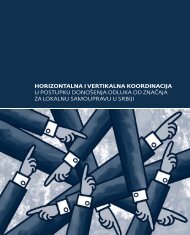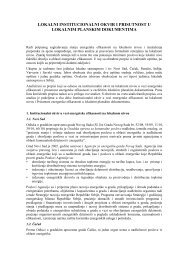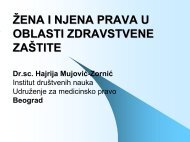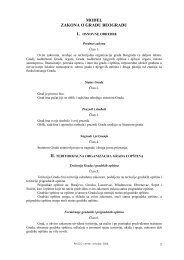Brošura u pdf. formatu - PALGO centar
Brošura u pdf. formatu - PALGO centar
Brošura u pdf. formatu - PALGO centar
You also want an ePaper? Increase the reach of your titles
YUMPU automatically turns print PDFs into web optimized ePapers that Google loves.
se ne ispoljavaju na isti način kod žena i kod muškaraca; - neke<br />
bolesti su isključivo vezane za ženski pol; - bolesti kod žena<br />
često zahtevaju drugačiji pristup dijagnostici i lečenju nego<br />
kod muškaraca; - faktori rizika po zdravlje nisu isti za oba pola,<br />
pogotovo u pogledu nasilja na ženama; - dobra preventivna<br />
zaštita može dovesti do smanjenja obolevanja i produženja<br />
životnog veka žena. U razvijenim zemljama to je dovelo do<br />
veće pažnje društva i stvaranja svojevrsnih pokreta za zdravlje<br />
žena. Naročito su važni pravci razvoja i preporuke SZO u<br />
pogledu otklanjanja nejednakosti među polovima, smanjenja<br />
stope smrtnosti i invalidnosti porodilja, bezbednog abortusa,<br />
smanjenja nasilja nad ženama i programa zdravstvene zaštite<br />
žena na svim nivoima.<br />
Stanje ljudskih prava žena u oblasti zaštite zdravlja je deo<br />
šireg konteksta. Život i zdravlje svakog čoveka predstavljaju<br />
pravom zaštićena lična dobra, a iz toga proizilazi niz bazičnih<br />
i izvedenih prava iz korpusa tzv. pacijentovih prava. U osnovi<br />
većine od tih prava jeste pravo na samoodređenje i kontrolu<br />
vlastitog tela. Kod ženske populacije, u zavisnosti od konkretnih<br />
okolnosti i životnog veka, ova pitanja se tipično aktuelizuju<br />
kod: preventivne zaštite zdravlja žena, planiranja i kontrole<br />
rađanja u pozitivnom i negativnom pravcu, trudnoće, porođaja i<br />
materinstva, seksualne aktivnosti i rizika od prenosivih bolesti,<br />
prelaznog doba i starosti.<br />
Zaštita žena kroz zdravstveno zakonodavstvo Srbije danas<br />
je praktično redukovana na reproduktivnu ulogu žene. Većinom<br />
su to opšte odredbe o pojačanoj zaštiti žena, gde od posebnih<br />
zakona koji bi obuhvatnije posmatrali celokupnu oblast medicine<br />
rađanja, postoji samo Zakon o postupku prekida trudnoće u<br />
zdravstvenoj ustanovi (1995). Inače ovaj zakon je restriktivniji<br />
u propisivanju uslova za pobačaj po odobrenju u odnosu na<br />
prethodno važeći istoimeni zakon, zbog čega predstavlja<br />
korak unazad u pogledu slobode žene da odlučuje o pobačaju.<br />
Kod zaštite reproduktivnog zdravlja od suštinske je važnosti<br />
razumevanje tesne veze između ove zaštite i reproduktivnih<br />
prava, čije se ostvarivanje uvek treba omogućiti i respektovati<br />
od strane zdravstvenih službi, bez uticaja i pritisaka na slobodnu<br />
volju žene. To dolazi u prvi plan naročito kod sledećih pitanja:<br />
pravo na rađanje i mere potpomognutog oplođenja, pravo na<br />
kontrolu rađanja u pogledu željenog i zdravog potomstva, pravo<br />
na pobačaj uz specifičnosti ranog i kasnog pobačaja, pravo<br />
na sterilizaciju, prava trudnice kao pacijenta uz specifičnosti<br />
HiV-pozitivne trudnoće, prava porodilja, i prava vezana za<br />
ginekološko-hirurške intervencije.<br />
Potrebno je oblikovati koncept reprodukcije koji objašnjava<br />
i potvrđuje ideju o pravu na reprodukciju kao bazičnom<br />
ljudskom pravu. U većini liberalnih zapadnih demokratija<br />
smatra se da ljudi moralno i legalno uživaju prokreativnu<br />
slobodu ili prokreativnu autonomiju. Ona uključuje kako pravo<br />
na reprodukciju, tako i pravo da se spreči reprodukcija. Tako<br />
definisano pravo povlači za sobom niz spornih pitanja koja traže<br />
svoje razrešenje. Na primer, ko ima pravo na reprodukciju; da<br />
li njega uživaju samo venčani parovi ili i pojedinci; da li je ovo<br />
pravo ograničeno na heteroseksualne parove; da li je limitirano<br />
starosnom granicom titulara; da li mogu maloletne osobe ili<br />
starije žene u postmenopauzi imati pravo na reprodukciju;<br />
da li ovo pravo pripada samo fertilnim osobama koja mogu<br />
da rađaju prirodno, via coitus, ili i sterilne osobe imaju pravo<br />
na reprodukciju. Na ova pitanja ne može se dati odgovor bez<br />
koherentne koncepcije prava na reprodukciju u kontekstu zaštite<br />
reproduktivnog zdravlja. ■<br />
- health risk factors are not the same for both sexes, especially<br />
when it comes to violence against women; - good prevention can<br />
lead to decrease of diseases and to a longer life span of women.<br />
In developed countries, this has lead to greater attention of the<br />
society, and to the formation of specific movements for women’s<br />
health. Directions of development and WHO recommendations<br />
are especially important when it comes to eliminating gender<br />
inequality, reducing the level of mortality, and morbidity of new<br />
mothers, safe abortion, decrease of violence against women, and<br />
programs of health care for women at all levels.<br />
The status of women’s rights in health care is part of a<br />
broader context. The life and health of each individual are<br />
personal assets protected by the law, forming a basis for a series<br />
of basic and deduced rights belonging to the body of so called<br />
rights of patients. The basis of most such rights is formed by the<br />
right to self determination and to control over ones own body. In<br />
the famale population, depending on concrete circumstances and<br />
life span, such issues become typically current from the aspect<br />
of: preventive protection of women’s health, planning and<br />
control of reproduction in the positive or the negative direction,<br />
pregnancy, parturition and maternity, sexual activity, and risk<br />
from communicable diseases, menopause, and old age.<br />
Today, health protection of women in the health care<br />
legislation of Serbia is practically reduced to her reproductive<br />
role. There are mostly general provisions on the intensified<br />
protection for women, with only one specific law encompasing<br />
in more detail the entire area of reproductive medicine, the<br />
Law on Procedure for Termination of Pregnancy in a Health<br />
Care Institution (1995). When prescribing conditions for<br />
approved termination, this Law is in fact more restrictive than<br />
the previous Law under the same name, thus representing a<br />
retrograde step when it comes to the right of a woman to decide<br />
about an abortion. From the aspect of protection of reproductive<br />
health, it is very important to understand the close connection<br />
between this type of protection and the right of reproduction,<br />
which should always be enabled and respected by health care<br />
services, without any influence or pressure against the free will<br />
of the woman. This takes center stage especially in connection<br />
with the following issues: the right to give birth, and to measures<br />
of assisted ferilization, the right to birth control in the sense of<br />
desired and healthy offspring, the right to an abortion with the<br />
specificity of early and late abortion, the right to sterilization,<br />
the rights of pregnant women as patients belonging to the<br />
group of specific HIV-positivne pregnancies, the right of new<br />
mothers, and rights in connection with gynecological surgical<br />
interventions.<br />
There is the need to shape a concept of reproduction which<br />
explains and confirms the idea of the right to reproduction<br />
as a basic human right. In most liberal western democracies<br />
there is the view that people are morally and legally entitled<br />
to the freedom to procreate or the autonomy to procreate.<br />
This includes both the right to reproduce, and the right to<br />
prevent reproduction. The right thus defined implies a series<br />
of disputable issues demanding to be resolved. For example,<br />
who has the right to reproduce; is this the right only of married<br />
couples, or also of single individuals; is this right limited to<br />
heterosexual couples; is it limited by the age of the individual;<br />
can minors or older women during postmenopause have the<br />
right to reproduce; is this the right only of fertile individuals<br />
who can give birth naturally, via coitus, or do sterile persons also<br />
have the right to reproduce. These questions can not be answered<br />
without a coherent view of the right to reproduce in the context<br />
of protection of reproductive health. ■<br />
31

















